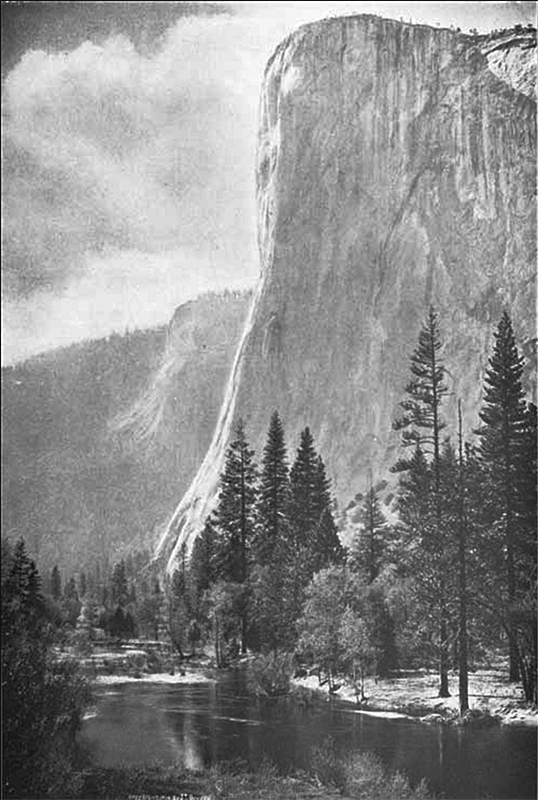
The first impressions we have of Yosemite come in the form of the legends of its first residents. Groups of Miwok and Paiute Indians settled in Yosemite between 4,000 and 8,000 years ago. They were hunters and gatherers living primarily off deer and other small game that populated the mountains and off ground acorn meal from the many black oak trees in the region. These Indians referred to themselves as the Ahwahnechee, the people who lived in the Ahwahnee Valley. Ahwahnee was the Miwok word used to describe the gaping, open, mouth of a bear. The Ahwahnechee saw the open end of their valley in this way. White miners and settlers began to move into the region with the discovery of gold in California in 1848. Contact with the newcomers brought devastation to the native population of the entire Mother Lode gold mining region. European diseases like small pox, war with those invading their ancestral lands, and removal to reservations brought an end to their traditional ways of life.1 Ahwahnechee legends include stories about the origins of their valley and many of its most remarkable features. These stories often incorporate important morals for young listeners. The one that follows is no exception. It is the story of the formation of El Capitan, the valley's most prominent mountain. It is often told involving young bear cubs, but the following version tells of two young boys tired from a day's swimming and playing in the Merced River.
There were once two little boys living in the valley who went down to the river to swim. After paddling and splashing about to their hearts' content, they went on shore and crept up on a huge boulder which stood beside the water. They lay down in the warm sunshine to dry themselves, but fell asleep. They slept so soundly that they knew nothing, though the great boulder grew day by day, and rose night by night, until it lifted them up beyond the sight of their tribe, who looked for them everywhere.
Last of all Lion tried, and he jumped farther than any other animal, but fell down upon his back. Then came tiny Measuring-Worm, and began to creep up the rock. Soon he reached as high as Raccoon had jumped, then as high as Bear, then as high as Lion's leap, and by and by he was out of sight, climbing up the face of the rock. For one whole snow, Measuring-Worm climbed the rock, and at last he reached the top. Then he wakened the boys, and came down the same way he went up, and brought them down safely to the ground. Therefore the rock is called Tutokanula, the measuring worm. But white men call it El Capitan.
The story of a growing El Capitan suggests a great geologic uplift. In fact, this was a part of the distant history of the Sierra Nevada Mountains of which Yosemite is a part. A more important part of the geologic story of the Sierras and Yosemite Valley in particular, though, is one of glacial erosion. During three different ice ages, the last ending over 10,000 years ago, glaciers dug through the valley of the Merced River eating away at the weaker portions of the surrounding granite, carving the faces of Yosemite's mountains and the U-shaped valley in which the Ahwahnechee eventually settled and that we know today.3
1) The Ahwahnechee of Yosemite Valley, like many other native American groups, used fire as a tool in helping to manage their food supply. What advantage do you think there would be in burning the valley floor if you relied on deer hunting and acorn gathering for food?
2) What is the moral of the legend of the origin of El Capitan? Does the story remind you of stories you heard as a child? If so, describe the similarities.
3) Imagine the glacier 2,000 to 3,000 feet deep grinding away at the granite bedrock of Yosemite as it pushed its way through the valley. When the glacier receded it left the polished walls of the granite cliffs like El Capitan pictured above. What would you expect to find left behind by the glacier on the valley floor?
1Craig D. Bates, The Miwok in Yosemite, (The Yosemite Association, 1996).
2from Katharine Berry Judson, The Project Gutenberg Etext of Myths and Legends of California and the Old Southwest (Champaign, Illinois: Project Gutenberg, 2001) .
3National Park Service, "Geology Field Notes: Yosemite National Park, California" (National Park Service, Geologic Resources Division, 1998).
images from Chris Jorgenson, "Indian O'Chum"in Galen Clark, 1814-1910. Indians of the Yosemite Valley and vicinity: Their history, customs and traditions 1st edition (Yosemite Valley, California: G. Clark, 1904) and J.T. Boysen, "El Capitan & the Merced River"in Robert Sterling Yard, editor, The National Parks Portfolio, 6th edition (Washington: The United States Government Printing Office,

